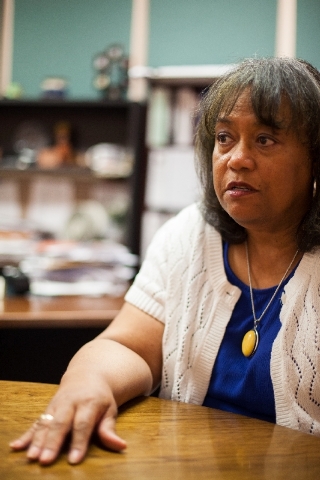Demise of solar project dims Laughlin’s hopes
LAUGHLIN
Laughlin is the sort of place that attracts guys like Chuck Gilmore.
The 71-year-old retired high school business teacher bought a vacation home here 23 years ago and spends his days buzzing around the Colorado River on personal watercraft.
The unincorporated Clark County town bordering the Colorado River has combined the lure of gambling and recreation, starting with Don Laughlin’s opening of the Riverside Resort in 1966. Its economy hasn’t strayed beyond its roots.
Not long ago, it appeared Laughlin was in for an economic revamp. But ENN Mojave Energy, a China-based company, failed to deliver on its deal with the county to build a solar energy plant and panel manufacturing plant on 9,000 acres south of Laughlin. The company was unable to meet an 18-month deadline to have a power purchase agreement in hand.
No one doubts that gambling and tourism will continue to have a strong place in Laughlin, despite its hot, remote location about 96 miles south of Las Vegas. The lingering question is if it will remain a small town with a gaming-based economy or diversify its base and start growing.
Local views are mixed on whether the town’s business base will substantially broaden into other industries, solar or otherwise, following the failure of the ENN proposal.
COUNTY REGROUPS
For the past 18 months, officials were banking on the prospect of ENN setting up a solar power plant and panel factory. The company dropped out this month, unable to meet the deadline to secure a power purchase agreement, putting the vacant land back in Clark County’s hands.
County officials plan to seek other developers for the land.
“They really pinned their hopes on it,” Gilmore said, adding that he was skeptical about the project’s chances of success. “Everyone was talking about what a great thing it was going to be. I was like, ‘Don’t hold your breath.’ ”
Had the project happened, it would have altered the economic landscape of Laughlin, putting upwards of 2,222 jobs into a community that had about 7,323 people in the 2010 census. That could have infused the town with residential and housing growth.
For Laughlin residents, diversifying the economy is about more than solar energy projects. It’s also about gaining everyday businesses that don’t generate headlines.
“The majority of people that live in Laughlin, they want services,” said James Vincent, chairman of the Laughlin Town Advisory Board. “We don’t even have a pharmacy. They would like to see doctors and dentists.”
Now those activities, along with big-box and grocery stores, require a trip to neighboring Bullhead City, Ariz., right across the river.
NEXT STEPS
County commissioners and management will talk about marketing the former ENN land at their meeting Tuesday. The initial marketing work will take several months, and proposals will be sought to get a sense of what’s out there, County Manager Don Burnette said.
As an unincorporated town, Laughlin falls under the county’s jurisdiction.
The county obtained the Colorado River Commission land in 2007. Before ENN signed on, officials were open to other potential uses too, such as medical, manufacturing or warehousing, in addition to renewable energy.
They remain open to renewable energy projects, but other options, particularly with a distribution or manufacturing focus, are possible, too.
The next effort could start on a smaller scale compared to ENN, at least initially. Officials said part of that project’s uniqueness was that it would have filled up all 9,000 acres.
“I think it still has value for renewable energy projects,” Burnette said. “Now, does it have to be the entire 9,000 acres? No.”
At the same time, officials note that the large size of the tract could be a draw. Also, other companies had approached the county before the ENN deal was inked.
“I don’t know of too many places that have 9,000 acres sitting right here on the mighty Colorado River,” said Laughlin Town Manager Jacquelyne Brady.
But officials also are aware that reshaping Laughlin cannot happen overnight.
“People always talk about diversification,” Brady said. “It’s harder to do than it is to talk about.”
Although Laughlin’s economy hasn’t changed much in recent years, Bullhead City has grown. The city has a Wal-Mart, Sam’s Club and an assortment of chain restaurants. It’s also where Laughlin residents go for medical care.
Laughlin’s population grew just 3.49 percent from 2000 to 2010, up by just 247 people to 7,323. Bullhead City, meanwhile, grew by 17 percent in that same time frame, expanding from 33,769 to 39,540.
Many casino workers live in Bullhead City.
Bullhead City Manager Toby Cotter said his city owes much of its growth to Laughlin. In 1980, Bullhead City’s population was just 10,719.
People on both sides of the river rely on the other for various needs. For example, Bullhead City residents cross over for casino buffet meals, and Laughlin residents head to the other side for grocery shopping.
“You don’t have one without the other,” said Sara Barone, of Bullhead City.
FUTURE NEEDS
Laughlin has unmet needs besides developing the land.
For years, officials have discussed adding a second bridge across the Colorado River.
Another desire is to improve the California side of U.S. Highway 95, a two-lane highway that goes to Needles. Clark County made improvements to the Nevada side in 2006.
An upgraded, expanded highway would give Laughlin more potential for distribution and transportation-related development, officials say.
That’s because Needles is tied to Interstate 40 and also the site of a BNSF railroad operation. The so-called Needles Highway also runs alongside the 9,000 acres.
But both of those potential improvements are years away from becoming a reality.
Design work on the bridge could take a year or two. The construction timeline will depend on funding, Brady said.
Needles City Manager David Brownlee Jr., who commutes from Laughlin to work, said California regulations lengthen the time needed for environmental studies.
He said construction on the California side could start in 2015. The goal is to elevate the two-lane road over washes, making it safer to navigate.
The scope of the project also depends on how much transportation funding is available. The road could become a four-lane highway, or it could be a two-lane project with improvements and cutouts allowing traffic to pass, Brownlee said.
Laughlin does have extra water available, enough to more than double its usage. Its allocation is 15,353 acre-feet per year, and it uses less than half of that. The town rarely uses more than 5,000 acre-feet each year, said J.C. Davis, spokesman for the Southern Nevada Water Authority.
An acre-foot of water is enough for about two households for a year.
As for Gilmore, he would like to see more progress with the second bridge, noting that it has been in the works for years. But he doesn’t have any complaints about his neighbors.
“This is still a small town,” he said. “It’s still quiet.”
Contact reporter Ben Botkin at
bbotkin@reviewjournal. com or 702-405-9781.



















